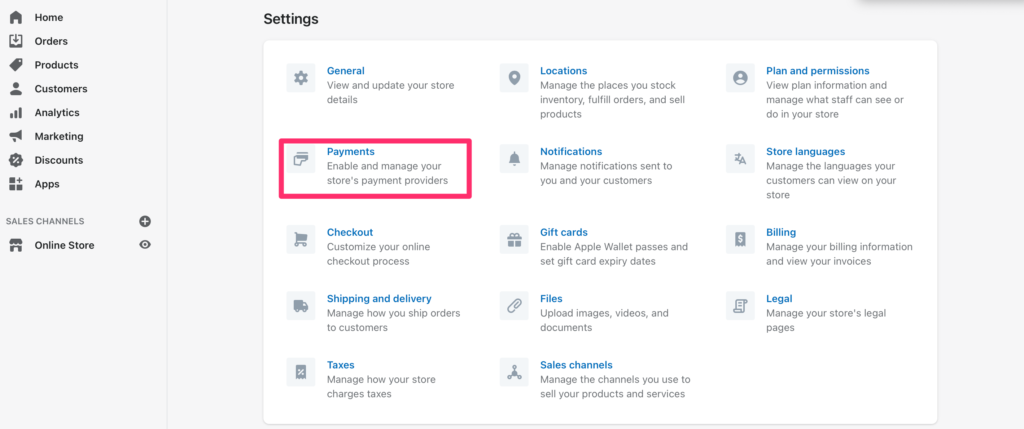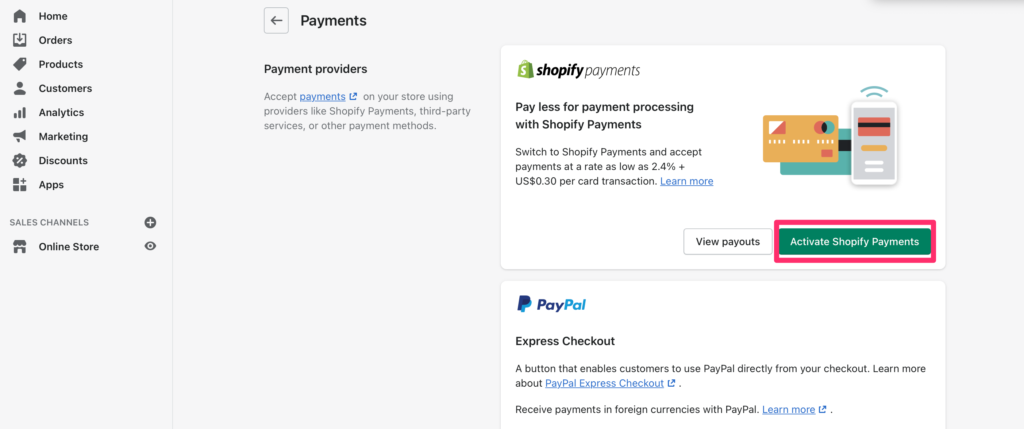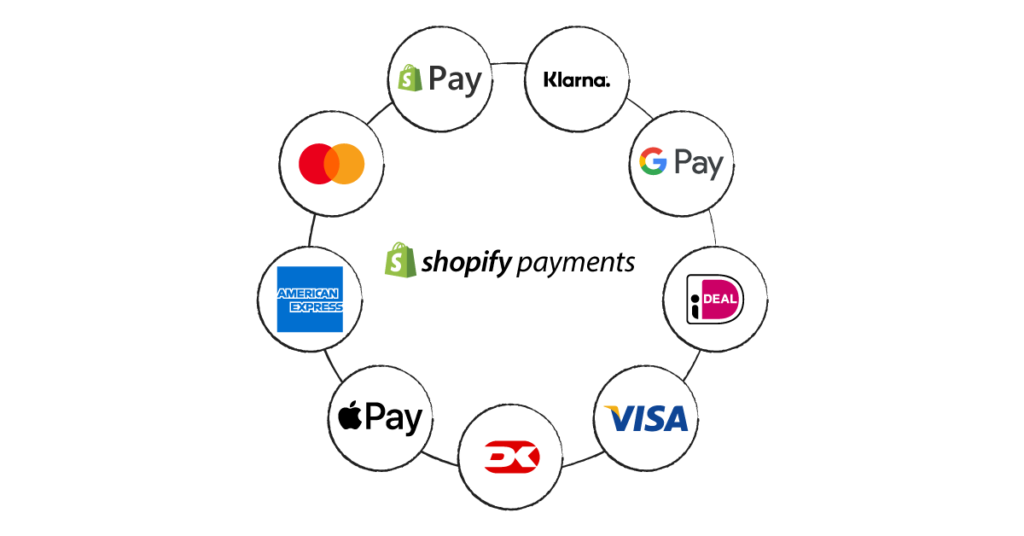Payment gateways are platforms, like PayPal, Square, and Stripe, that process credit card payments for ecommerce sites. Although there are a number of payment gateways you can use on your site, getting approval can take a long time. You also have to worry about integrating the gateway with your store and the processing fees, which might be on the high end, especially for small businesses.
That’s where Shopify Payments comes in. In this post, we’ll look into what Shopify Payments is, its features, the pros and cons, and how to set it up.
What is Shopify Payments?
Shopify Payments is a payment gateway used to receive and process online payments on Shopify stores.The payment gateway was launched on August 12, 2013, in a partnership with Stripe to help ecommerce merchants process payments online without going through third-party providers. It’s fully integrated with Shopify’s ecosystem, allowing you to receive payments directly on your Shopify store.
Shopify Payments is designed to help small and medium ecommerce store owners process money without any complexity. Unlike traditional payment methods, it’s simple to get approval for Shopify Payments. Also, setting up is straightforward and doesn’t require any advanced knowledge or skills. You don’t have to register for multiple third-party payment solutions or manage multiple dashboards.
The Payments platform integrates with over 100 other payment options like PayPal, Apple Pay, and Amazon Pay. These integrations allow you to provide your customers with a wide range of payment options. At the same time, you can manage your sales from multiple payment providers and keep track of your inventory and profit margins in a dashboard.
How does Shopify Payments work with different credit card platforms?
According to Shopify, there are two main payment providers that you can use to process your customers’ credit card payments. Direct payment providers do not redirect customers to another checkout platform when making credit card payments. Instead, customers can complete their order at Shopify’s checkout. With external payment providers, customers are redirected from Shopify checkout to a third-party checkout to complete their order. Once customers’ payments have been processed, they’ll be redirected back to Shopify. Examples of external payment providers are PayPal, Stripe, Apple Pay, and Amazon Pay.Advantages of using Shopify Payments
If you’re wondering why you should use Shopify Payments, this section is for you.Easy to set up and manage
Setting up Shopify Payments is pretty straightforward. You don’t need to wait a long time to get approval. This is not the case with traditional payment methods. You need to apply for a merchant account on a third-party provider and go through their rigorous approval process. And when you’ve done all that, you need to apply to multiple third-party providers before you can offer your customers a variety of payment options. Each provider has its own dashboard, which might be hard to manage. Shopify Payments, on the other hand, is integrated into your Shopify store, and you can start processing payments once you’ve provided the relevant information. You can manage orders, sales, shipping inventory, and refunds in real time on one dashboard.Accelerated checkouts
A study done by Baymard shows that 28% of shoppers abandon their cart during checkout because the process was too complex. However, using Shop Pay with Shopify Payments makes checkout less complicated. Shop Pay is an accelerated checkout system that stores customers’ details while checking out, so they can complete checkout faster the next time. Since their credit card details are stored, returning customers can process orders on your store with just a click. And to protect customers, Shopify Payments stores personal and financial credentials on their Payment Card Industry (PCI)-compliant servers.Discounted card processing fee
Another major advantage of Shopify Payments is its processing fee, which is relatively low compared to other payment processors. Users of Shopify Payments don’t have to pay the commission Shopify usually takes on top of gateway fees. Depending on your Shopify plan, your service charge can be around 2.4%-2.9% + 30 cents for every online card payment. This rate is quite affordable compared to PayPal’s charges. PayPal charges you 2.9% of the transaction amount plus a flat fee of 30 cents if your business is in the U.S. If your company is outside the U.S., you’ll pay the fee for receiving U.S. payments plus an additional percentage-based fee for international transactions. In a nutshell, Shopify Payments helps you save money and can also increase your profit margin.Multiple currency processing
With Shopify Payments, you can sell to international customers with ease. Customers can view your products and pay for them in their local currency. And for each country or region you’re selling in, you can set the exchange rate either manually or against the current market exchange rate. You can also show prices and accept payments for different countries in their local currency. Shopify Payments supports more than 130 different currencies, thereby allowing you to serve customers in other countries and regions.Challenges of using Shopify Payment
Just like every other payment option, Shopify Payments has its own shortcomings.Chargeback fees
A chargeback is the forced reversal of funds initiated by a cardholder’s bank or issuer. It can occur if a customer wants to be reimbursed for a purchase or if their card is used to make a payment without their knowledge. If a chargeback is in favor of the buyer, you will not only be making refunds — you will also be charged the processing fee for the chargeback investigation. Shopify will charge you a processing fee of $15 if you’re in the U.S. If you’re not in the U.S., the processing fee may vary. If the chargeback goes in your favor, Shopify will refund you the chargeback processing fee. While investigating a chargeback, Shopify can withhold your money. And according to Shopify, it might take up to 120 days to resolve a chargeback claim.It is not available to everyone
Even though Shopify is open to merchants worldwide, Shopify Payments is not. The payment option is only available if your business operates in these 17 supported countries, which include Canada, the United Kingdom, Japan, Australia, and the U.S. Businesses operating outside these eligible regions will have to consider other payment options. Additionally, not all businesses are eligible to use Shopify Payments. Before you consider using the payment solution, check out the list of prohibited products on Shopify’s website. Failure to comply with Shopify’s terms and conditions may lead to the termination of your account without prior notice.How much does it cost to use Shopify Payments?
Here’s a breakdown of how much using Shopify and Shopify Payments will cost you:| Price | Shopify Payments Rates |
|---|---|
| Basic Shopify Plan | $29/month – 2.9% + $0.30 (online), 2.7% + $0.00 (in-person) |
| Shopify Plan | $79/month – 2.6% + $0.30 (online), 2.5% + $0.00 (in-person) |
| Advanced Shopify Plan | $299/month – 2.4% + $0.30 (online), 2.4% + $0.00 (in-person) |
Keep these costs in mind when making a decision regarding Shopify Payments.
How to set up Shopify Payments
Setting up Shopify Payments is pretty easy. If you’re new to Shopify, the first step is to set up your Shopify store. Once your store is ready, you can then set up Shopify Payments for your store.Step 1: Make sure your bank account meets the requirements
Before connecting your bank account to Shopify Payments, you need to make sure it meets Shopify’s requirements. Additionally, the account must use the payout currency in your region and must be able to accept electronic bank transfers. You should bear in mind that Shopify Payments does not accept saving accounts, virtual accounts, flex-currency accounts, and money-transferring services. Also, checking accounts that can only accept wire transfers are not supported.Step 2: Determine your currency
Once you’ve confirmed that your bank account meets Shopify Payments requirements, the next step is to determine your store currency. This is the currency in which your products will be priced.Step 3: Activate Shopify Payments
From your Shopify admin, click on Settings, and then click Payments. Next, click Activate Shopify Payments. If you have an existing credit card payment provider that you want to replace with Shopify Payments, this is the option you’ll be provided. If you’re setting up a credit card payment provider on your account for the first time, you’ll see an option to Complete account setup and proceed from there.

Step 4: Enter business details
After activating Shopify Payments on your account, you need to input your business details — including your business type — for verification in the Business details section. If your business is registered, you’ll need to provide your business number, business address, and Employer Identification Number (EIN) or Tax Identification Number (TIN). However, if you’re set up as an LLC or a corporation, you’ll need to provide your name and date of birth. And as for your name, it must match what’s on your legal government-issued ID.Step 5: Enter personal details
Shopify Payments requires you to provide your personal information as well. This is a regulatory process required by companies that process payments to identify their users and prevent money laundering.Step 6: Make a test transaction
The next step is to make a test transaction to see how customers will process orders. To do this, you need to enable test mode. To enable test mode, go to your Shopify admin dashboard. Then, go to Settings >>Payments. Next, go to the Shopify Payments section and click Manage. Go to the Test mode section at the bottom of the page and select Enable test mode. Click Save. After testing, disable test mode because your customers can’t pay with a real credit card in this mode.Frequently asked questions about Shopify Payments
In this section, we will cover common questions about Shopify Payments.How safe is Shopify Payments?
Shopify Payments is safe for both merchants and buyers. It’s self-hosted, which makes it easy to roll out periodic security updates on all of their stores. You are not required to install any open-source plugins on your store that may put it at risk. Shopify also ensures that all its stores comply with PCI standards. This standard protects your customers’ details from getting into the wrong hands. Additionally, Shopify makes use of HTTPS protocol and free SSL encryption to protect customers’ credit card information when processing their orders. The platform is also equipped with a fraud detection system that flags potential fraudulent transactions.Does Shopify Payments hold your money?
Shopify Payments may hold your money when investigating chargebacks. This might be detrimental to small business owners who do not have cash reserves to keep their business running. Your money will be released to you once the investigation has been completed.Does Shopify protect me from chargebacks?
No, chargebacks are your responsibility. Shopify can assist you by providing supporting documentation to dispute the chargeback, but it is the cardholder’s bank that decides a chargeback outcome. Shopify can’t change or appeal the bank’s decision.What types of cards does Shopify Payments accept?
Using Shopify Payments, you can accept the following debit and credit cards on your store:- MasterCard
- Visa
- American Express
- JCB
- Discover
- Diners Club
How long will it take for Shopify Payments to pay me?
Depending on your location, it may take two to four business days before you receive payments in your bank account.Does Shopify Payments have any processing limits?
There is no limit to how much you can accept through Shopify Payments. Regardless of the amount per month or transaction, your funds will be sent to your bank account whenever a payout is due.How can I view my payouts on Shopify Payments?
You can view your payout using the following steps:- Go to the Admin section of your dashboard.
- Click on the Settings tab.
- Click on the Payment providers option.
- Click on Shopify Payments and click View payouts.
Is Shopify Payments right for me?
Shopify Payments is a simple and straightforward solution for ecommerce merchants. It’s easy to set up, and you don’t need a team of developers to get started using the platform. It supports tons of other third-party payment providers, thereby allowing you to provide a wide variety of options to your customers when checking out. Shopify Payments is also ideal for merchants looking for a payment solution with relatively low transaction fees. Also, it’s easy for first-time ecommerce merchants and less complicated compared to traditional payment providers.Are you adding Shopify to your multi-channel selling stack? Use SellerSkills to seamlessly integrate your operations with the rest of your business.
